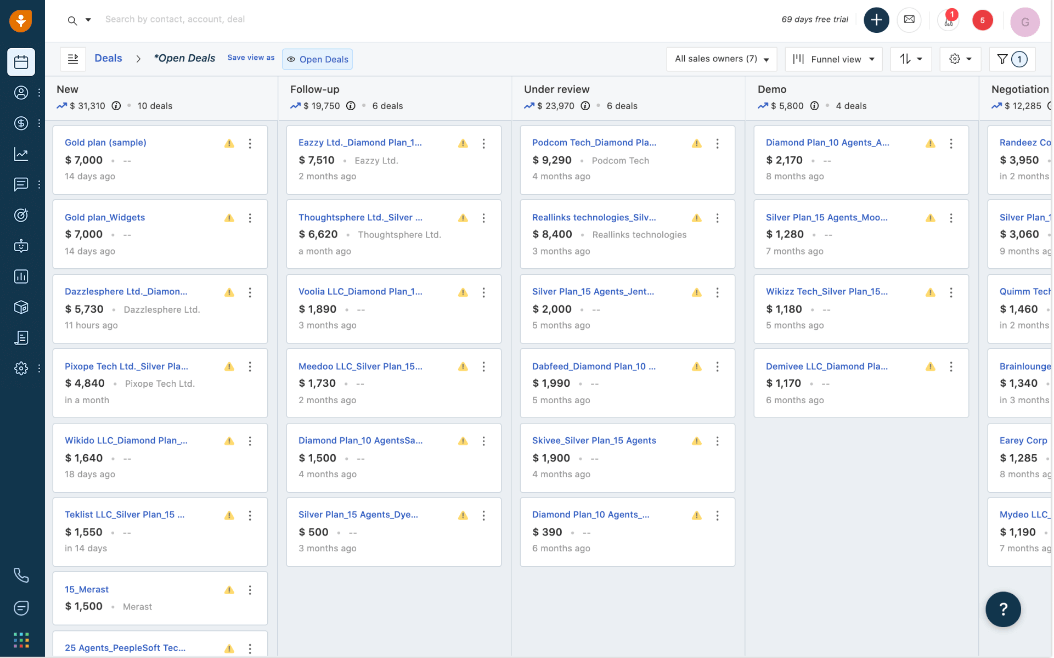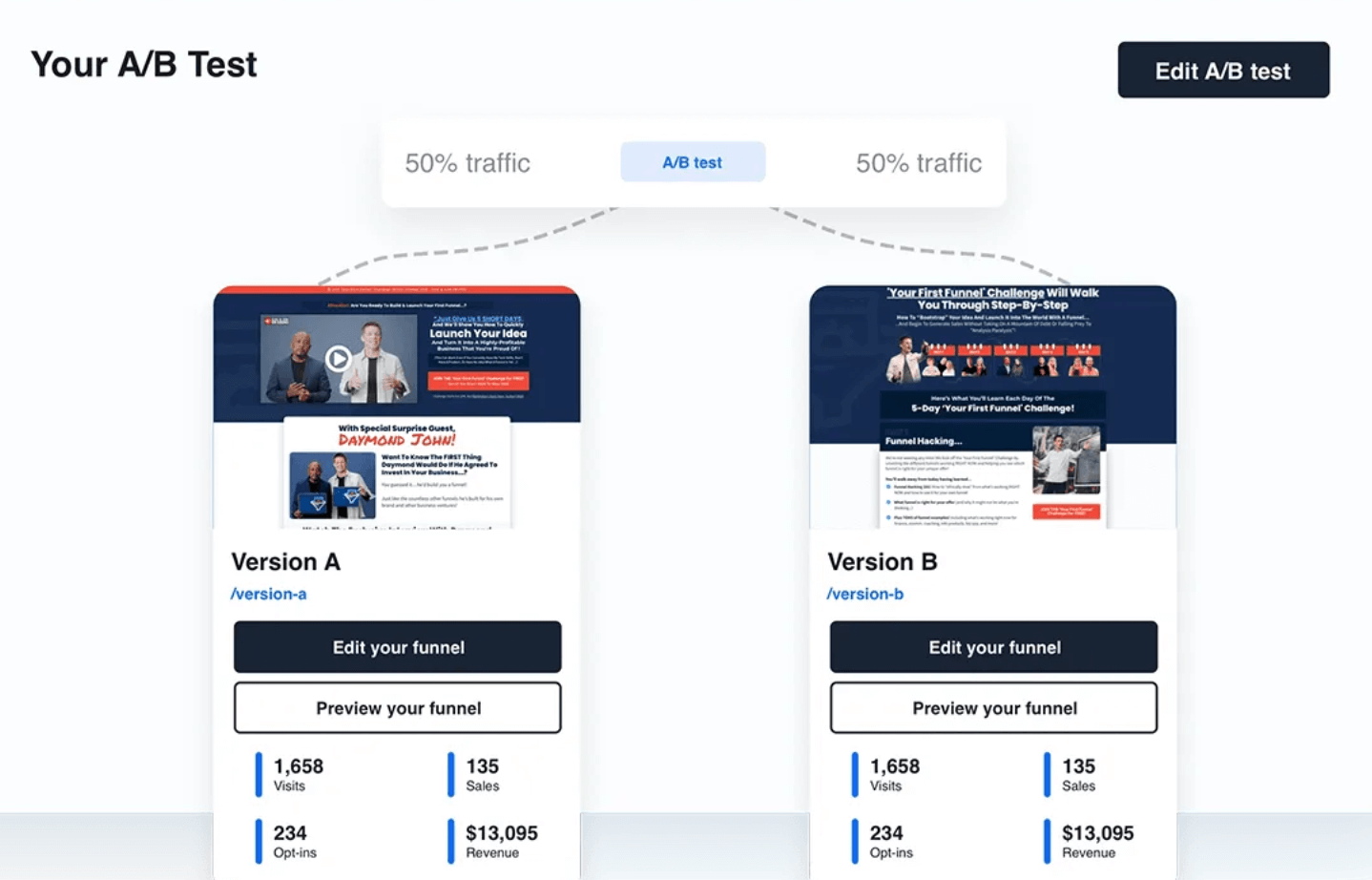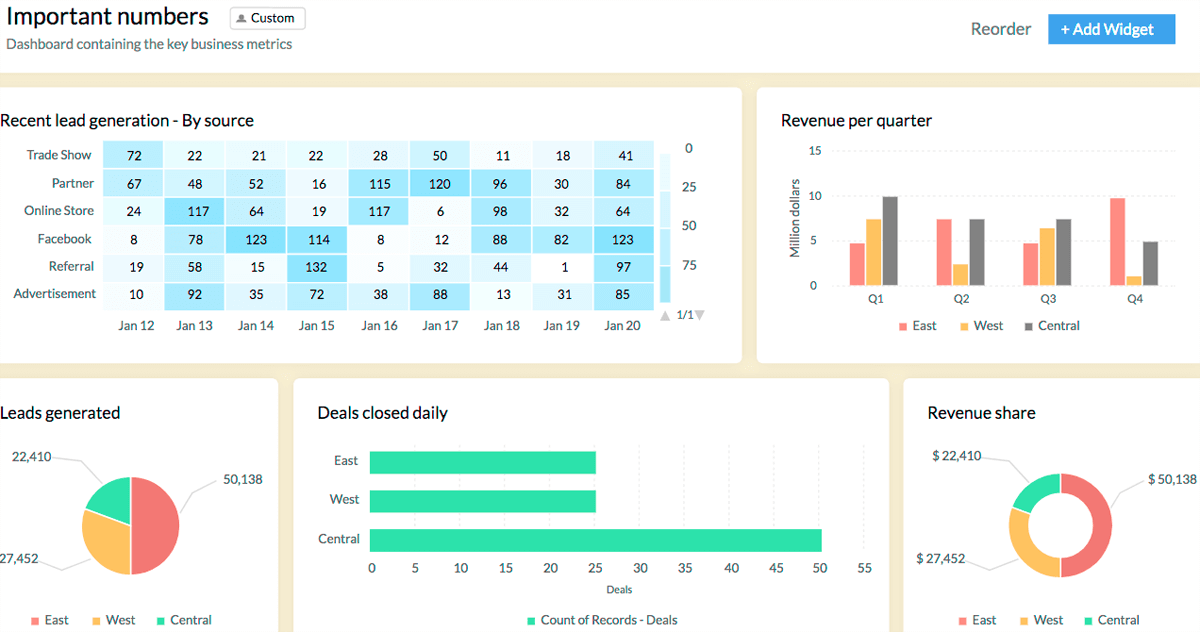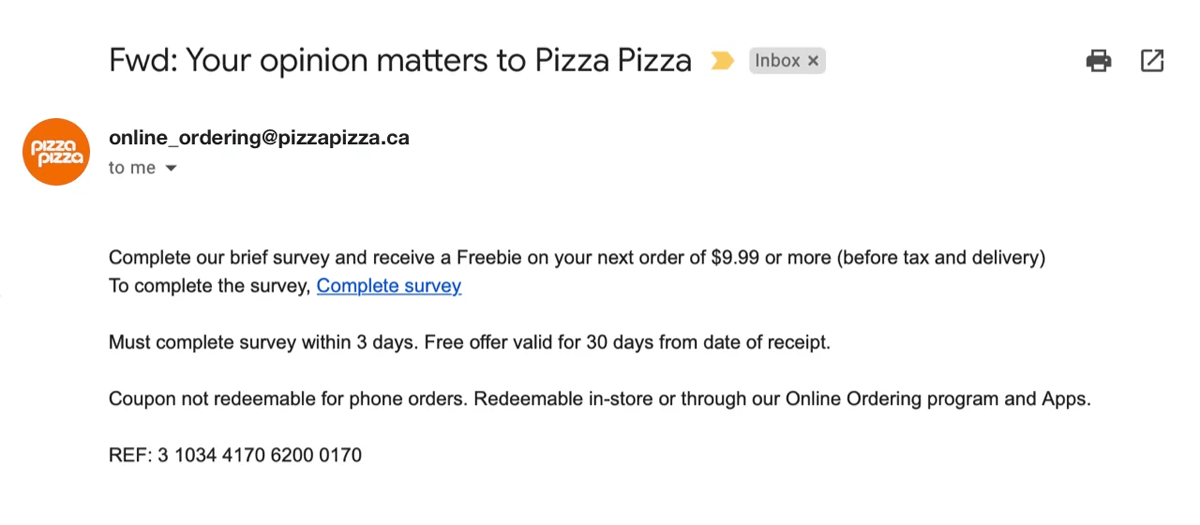Learn the differences between leads, prospects, and opportunities. Understand how to turn leads into prospects and opportunities.
Sales funnel management is the ongoing process of monitoring, analyzing, and improving your business’s sales funnel, which is the visual representation of the customer journey from the buyer’s point of view. Funnel management involves activities like tracking conversion rates between stages and identifying weak points in the funnel. Consistent, methodical sales funnel management results in more closed deals, improved forecasting, and lower customer acquisition costs.
Salespeople and marketers engage in a range of sales funnel management activities — from monitoring funnel metrics to A/B testing marketing material — in an ongoing effort to remove funnel friction, improve the customer experience, and gradually optimize their funnel. There are many sales funnel management activities to choose from, and you can do any of them individually, but following a systematic process often gets the best results.
Below is a step-by-step sales funnel management process:
Some of these tasks you’ll do more frequently than others. Tracking funnel metrics is an everyday action if it’s on your sales dashboard. But evaluating your sales funnel software to see if it needs a tune-up is something you’ll do once every year or two.
If this is your first time analyzing your funnel in a while, follow every step. Otherwise, prioritize the methods that you haven’t done in recently. Whether you’re doing them all or skipping some, try to do them in order, as some steps build on previous ones.
Sales funnels help salespeople understand what potential customers are doing and thinking at every stage of the customer journey so you can use the most relevant sales and marketing techniques to move them forward. A seller who's familiar with their customer journey will have an easier time predicting a certain lead’s experience so far and current thoughts about the brand than someone who has forgotten the journey’s steps or never taken the time to learn it.
Therefore, it’s a good practice every six months to pretend to be the average customer and go through the customer journey as they would, from initial awareness of the brand to the first time you decide to renew the service. See what the landing page they see, feel the excitement they feel. Afterward, you’ll have a better sense of the journey, and you’ll know almost instinctively what leads need from you in each stage.
Sales funnel software helps you build and manage your sales funnel, track leads as they move through it, and automate marketing tasks that push leads down the funnel. These tools also make managing your funnel much easier. For example, many come with funnel metric monitoring, funnel reporting to spot leakages, and A/B testing capabilities. Though there are point solutions, most businesses use CRMs as their sales funnel software.
Here are three of the best CRMs for sales funnel management on the market:
If you already have a CRM, check to see if it offers sales funnel management features. If you discover that it’s lacking some functionality you’d like, consider finding a point solution that you can integrate into your current platform. For example, if your CRM is great for funnel management but lacks a landing page builder, you can probably find a tool like Leadpages to connect it with, or find another CRM that satisfies your sales funnel needs.

To improve interdepartmental cooperation, hold monthly meetings between sales and marketing leaders and align on various aspects of your sales funnel, including sales funnel key performance indicators (KPIs), the requirements for entry into each stage, what makes an ideal lead, and any current sales or marketing objectives. This will enable marketing to support sales with the right content and lead generation initiatives.
Let’s go over the details sales and marketing should agree on:
Frequent communication outside of these regular meetings is also essential for quality sales funnel management. Imagine that a sales rep suspects a problem with the lead magnet’s landing page based on their conversations with leads, but doesn’t have the power or software access to change it. To address the problem, the rep needs to be able to easily communicate with marketing, who can get into the landing page builder and fix it.
In step one, you reviewed the average customer journey in an effort to understand it and its various parts. Now it’s time to review it with a critical eye. Review the various things a lead experiences — welcome emails, landing pages, sales pages, web demos, sales calls — and think about their merits and faults. Questions help to guide your critical analysis.
Stop at each step along the journey and ask the following questions:
For example, imagine that a rep is assessing a welcome email that leads receive if they sign up for a webinar. The email looks good, but it doesn’t answer a question leads might have at this point: “Will the webinar be recorded?” So the rep makes the change to the automated email. Writing down your findings as you go can help you manage A/B testing and prioritize which content to test.
In sales funnel management, A/B testing is the act of comparing a current version of your content to an alternate version in order to find the optimal layout, messaging, or strategy. Often, the metric you’ll use to determine the winner is conversion rate. For example, you could test a landing page with no image versus one with an image, send 100 leads to each version, track what percentage submits their contact information for each, and then go with the winner.
Here are some common pieces of your sales funnel to test:
You can test any part of your customer journey, from two web demo flows to different subject lines of a follow-up email. Prioritize testing content that is underperforming or that you believe could benefit from a change based on your qualitative judgments. Most sales funnel software platforms help you conduct these A/B tests, showing half of your leads one version and half the other while tracking conversion rates, open rates, or other success metrics.

Figure out where leads are exiting your sales funnel at an unusually high rate. Narrow down the leak’s location first to the stage of your sales funnel, and second to a specific webpage, email, or experience within that stage (e.g., the proposal review call in the decision stage). Look for steps in the journey that are usually the last ones leads take with your brand. Then you can figure out their cause and patch them up.
Here are some strategies to quickly identify potential leakage points:
Once you know the leak exists and its location, figure out why it’s happening. Often, this takes some learning on your part, then A/B testing. If you found that a major leakage point was your product’s pricing page, you should read articles on how to create effective pricing pages to come up with some reasons why yours is suffering. Then you can try these ideas out and A/B the new page against the old one.
Remember to consider the small details of whichever piece of content or action you’ve determined was a major leakage point. Sometimes a simple word change in your CTA can be enough to double an email’s clickthrough rate. The more you know about sales, marketing, and your target audience, the better you’ll be at finding the cause and coming up with a solution, so keep reading about how to optimize the various parts of your customer journey.
Tracking key sales funnel metrics and comparing them over time enables you to determine whether initiatives to improve your sales funnel are working. For example, if the sales funnel conversion rate rose for three consecutive months after altering your lead nurturing process, you can be sure that your strategy worked. Monitoring funnel metrics also helps you discover weaknesses in your sales funnel and find opportunities to improve it.
Here are some of the most critical sales funnel metrics to monitor over the long haul:
Most sales funnel software tools track these metrics for you and allow you to visualize this data in graphs, charts, and diagrams that you can keep on a dedicated user dashboard. This way, you always have a finger on the pulse of your sales funnel. You know how many people are in each stage, what actions you should prioritize, and anything else you want to track.

Make sure you’re doing all you can to effectively re-engage leads who drop out of your sales funnel. Whether they left in the awareness or the renewal stage, it’s likely that they’ll be easier to close than people totally unaware of your brand. Define what amount of time has to pass without interaction for a lead to be considered out of the funnel. A common standard is 30 days. Then, create a process that sales reps and marketers deploy to re-engage them.
Below are some strategies you can use to reignite relationships with leads:
The best re-engagement processes use multiple channels to get in touch. They also deliver content that’s relevant to the lead’s situation. Sometimes salespeople even monitor a lead’s LinkedIn or website and look out for trigger events, like a promotion or a change in address, that they can use to get their foot back in the door. For more on this topic, check out Spectrio’s article on the best re-engagement tactics, and see this example of a targeted discount email:

Interview current customers to find out what they liked and disliked about your customer journey. This can provide you with valuable insights for improving your funnel. You can do this in person, over the phone, or through an online survey that you ask them to fill out after becoming customers. It’s easy to create one of these surveys with a tool like SurveyMonkey.
Below are some examples of questions to ask customers in your conversations or surveys:
Leaving your questions open-ended will provide you with the most honest and comprehensive answers. Of course, these are easier to get someone to answer over a phone call. If you have customer success managers, have them arrange these calls with customers immediately after the implementation phase. For those who don’t personally interact with buyers, consider incentivizing leads to fill out surveys by entering them into a raffle or by giving them a discount.

Most sales funnel software tools provide you with the ability to create automations such as automatic follow-up emails, automated email campaigns, scheduled social media postings, and chatbots on your web pages. Tools with marketing automation and personalized workflows will even analyze a lead’s past behavior and current funnel stage and then send them content that best addresses their likely questions and concerns in an effort to move them to the next stage.
Automation features ensure that leads receive the right messaging, content, and outreach at the right time without needing you to send it to them. Plus, they free you up to focus on work that requires a human touch, like running a demo or negotiating a contract with a prospect. If you’re using software and unsure of what tasks it can take over for you, message the customer support staff or visit their knowledge center to learn what’s available and how to set it up.
We’ve covered a bunch of sales management methods, from refreshing yourself on the customer journey to identifying and repairing leaks in your funnel. After you’ve completed the process, set a reminder in your calendar to go through it again next year. Meanwhile, continue to do the more frequent methods, like A/B testing and monitoring metrics, as needed.
Sales pipeline management involves analyzing and optimizing the various activities that salespeople do to move customers toward a purchase. Sales funnel management, on the other hand, focuses on analyzing and improving the average customer experience across all interactions with marketing and sales. Sales pipeline management also only focuses on stages where salespeople are involved, while funnel management starts at the brand awareness stage.
Sales funnel management conducted regularly over the long term will help you progressively advance toward a state of sales funnel optimization, where a high percentage of your leads that enter the awareness stage convert into long-time customers. If you want to learn more about how a sales funnel works, check out our ultimate guide on sales funnels, where we cover its benefits, common stages, and more.